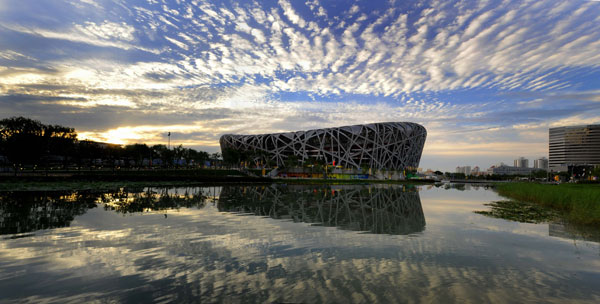Haze cure may need new Olympian vision
Updated: 2013-01-24 09:14
By Wu Wencong, Cui Jia and Tang Yue (China Daily)
|
||||||||
Beijing closed down as many as 150 highly polluting chemical engineering and cement factories. Most of the closures were temporary, but a few were permanent. Furthermore, thermoelectric-power generating companies were ordered to reduce emissions of pollutants by 30 percent through the use of low-sulfur coals and the installation of desulfurization units.
"Those were indeed intense measures, adopted over a very large area, and they produced pleasant air quality for Beijing during the 17-day Games," said Du. He noted that the average concentration of particulate matter was reduced to a record low for the time as the total emissions of airborne pollutants was cut by 60 percent.
 |
|
The Bird's Nest stadium under a blue sky on Aug 1, 2008. Experts have dismissed calls for a return to the measures adopted to control airborne pollution during the Beijing Olympics. Yang Lei / Xinhua |
However, if those measures had been implemented over the long term after the Games, it would have been difficult for people in the provinces surrounding the capital to maintain normal production and life, said Zhang Lei, an associate professor who studies environmental policies at the School of Environment and Natural Resources at Renmin University of China.
She said that more comprehensive and sustainable measures are needed to address the problem and the country should not be solely reliant on emergency action plans.
"Environmental protection work in China is still largely based on responding to emergencies and trying to clear up the mess only when things go wrong," said Zhang.
"It's like before you can prop up a fallen bottle, another one also falls, because the pace of our development is so rapid and the problems so diverse that we have no time to study each of them thoroughly enough or to prepare fully."
Traffic controls
During the Beijing Games, vehicles were only allowed on the capital's roads on alternate days, depending on whether the last digit of the driver's license plate was an odd or even number. In addition, more than 70 percent of government vehicles were banned from using the roads.
To ease traffic jams and air pollution, the vehicle controls continued after the Games but in a much lighter form. Currently, each car is banned from the road on one day on Monday through Friday within the areas of the Fifth Ring Road, depending on the license plate number, but there are no constraints at weekends.
However, the number of vehicles has increased sharply in Beijing. The city saw the number of vehicles rise by 515,000 in 2009 and a further 800,000 in 2010. To cope with the problem, a new system was introduced in 2011 to ensure that only 240,000 license plates were awarded annually.

 Li Na on Time cover, makes influential 100 list
Li Na on Time cover, makes influential 100 list
 FBI releases photos of 2 Boston bombings suspects
FBI releases photos of 2 Boston bombings suspects
 World's wackiest hairstyles
World's wackiest hairstyles
 Sandstorms strike Northwest China
Sandstorms strike Northwest China
 Never-seen photos of Madonna on display
Never-seen photos of Madonna on display
 H7N9 outbreak linked to waterfowl migration
H7N9 outbreak linked to waterfowl migration
 Dozens feared dead in Texas plant blast
Dozens feared dead in Texas plant blast
 Venezuelan court rules out manual votes counting
Venezuelan court rules out manual votes counting
Most Viewed
Editor's Picks

|

|

|

|

|

|
Today's Top News
Boston bombing suspect reported cornered on boat
7.0-magnitude quake hits Sichuan
Cross-talk artist helps to spread the word
'Green' awareness levels drop in Beijing
Palace Museum spruces up
First couple on Time's list of most influential
H7N9 flu transmission studied
Trading channels 'need to broaden'
US Weekly

|

|







